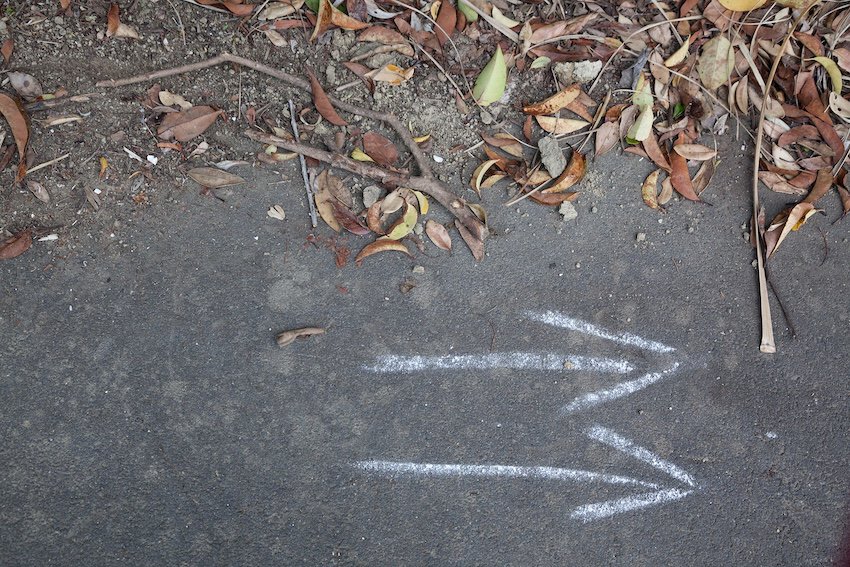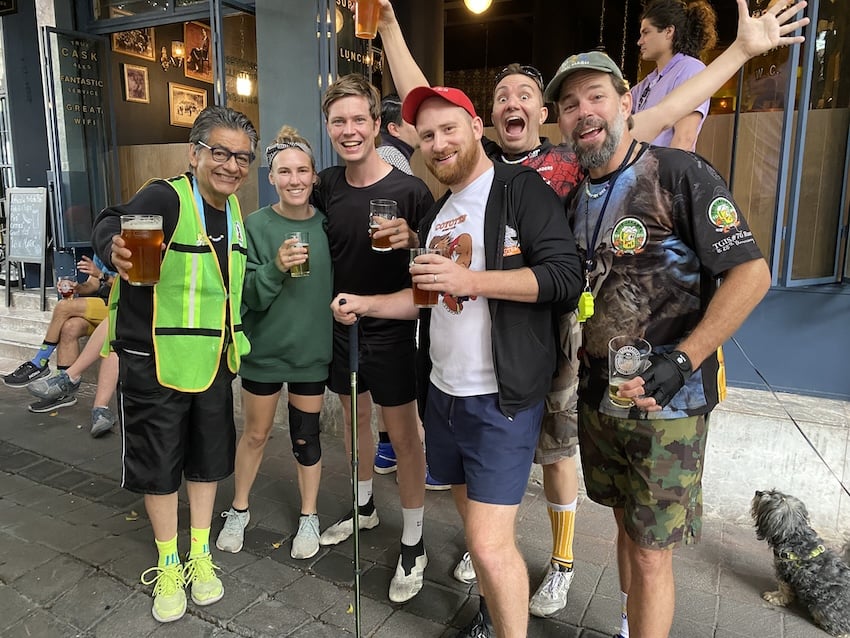Ever wanted to meet new people, have a great time and get fit doing it? Look no further than the Mexico City Hash House Harriers.
“Hashing” is a non-competitive fun run in which two or three runners (the hares) lay a trail in paper, flour, or chalk for the rest of the runners (the pack) to follow. The course is usually somewhere between seven and twelve kilometers in length, but there will be shortcuts and ‘checks’. A check is where the trail suddenly stops and the runners have to search for the next mark. This offers the fitter “athletes” a chance to go dashing off looking for the new trail, while the walkers can take a break. If they search in the wrong direction, the fastest runners can suddenly find themselves behind everybody else and will have to work hard to catch up. A good hash is one where the fastest and slowest runners get to the finish within a few minutes of each other.

Unlike many running clubs, however, the Hash House Harriers has a strong social focus, with runs ending at local bars. Here hashers will often spend the rest of the afternoon (and in some cases, evening), celebrating their achievements and reviewing the run that day. This has given rise to the nickname “The drinking club with a running problem.” While alcohol is optional (of course), hashers often enjoy a well-earned drink or three at the end of every hash.
When did all this start?
‘Hares and Hounds’ paper chases started in English public schools in the early 19th century. Rather than employing tutors, sending rich young boys to posh boarding schools became fashionable, with Rugby and Eton being the most famous. Many of these boys were keen hunters, but that was impossible in school. Instead, they would send a couple of their better runners off with a large bag of paper to set a trail across the local countryside. After giving these ‘hares’ a head start, the rest of the boys (the hounds) would set off in pursuit. These school races played an important role in the development of modern cross-country running. These hare and hounds paper chases were taken overseas by British officials and became particularly popular in Malaysia, where there were several clubs in the 1930s. Hashing dates back to 1938 when a group of expatriates working in Kuala Lumpur established a paper chase club called the “Hash House Harriers.”
During the 1960s, a dozen other hashes opened up around Malaysia, but it was the 1970s that brought real growth. The jogging craze had begun, and the expatriate community had become far more mobile. Suddenly, hash groups started to spring up all around the world and today, you can find a hash just about anywhere, from Tokyo to Buenos Aires.
Is it true hashers all use secret names?
Most of us do have a hash name, or a “handle” as we call it. This started in Jakarta in the early seventies. It could get pretty wild after a run, with the boys going on to the local discos after the run. As a report of events was published in a newsletter, “hash names” were adopted to keep activities secret from wives and bosses. It didn’t work, of course. In communities such as Jakarta or Bangkok, you were more likely to be addressed by your hash name than your real name!

What about hashing here in Mexico?
You don’t need to travel to some exotic Asian jungle to find a hash group, there are three groups (or kennels as they call themselves) in Mexico including Mexico City H3 who meet every other Saturday. The venue changes every run, but Polanco, Roma, and Coyoacán are regular meeting places. Hashers gather at 2:00 p.m. and are called around by the leader of the group – the Grand Master. They will welcome newcomers and invite the two hares, who have set today’s trail, to warn everybody what they might expect.
If there are newcomers to hashing or visitors from another hash, the hares will explain the marks. Chalk arrows drawn on the ground or on posts tell where you are in which direction you should be heading. A circle signifies a break in the trail, where the faster runners spread out to find the next arrow, which can be anywhere within 100 to 150 meters in any direction.
There are a few marks unique to Mexico. DGK means Don’t Get Killed, and it is written at busy road junctions that need to be crossed. Then there is BS – which brings a cheer from those listening because it stands for Beer Stop and means a pub has been selected for an early beer close to the end of the run.
With the marks explained, the Grand Master will shout On On and the pack set off following the first of the arrows that will mark the path around today’s 5-7 km trail. Some hashers will already be racing down the road, others will have settled into a walking pack at the back. Hashing caters for everybody!

There has been a hash in Mexico City since October 1983. Many of the founders worked in the oil industry and had hashed in other places around the world. Embassy staff also played a key role in setting up the group. Mexican colleagues from work were encouraged to join and while most of the ex-pats have moved on, a few of the Mexican pioneers are still running with us today.
Mexico City H3 hash every other week, but we are now back in full swing after COVID-19, and always welcome new hashers!
The post-COVID era started around October 2021 and numbers are climbing. Traffic makes getting out of town a problem, so we often run in the city. Even then we can still find interesting places. A few weeks ago, a run in the south of the town went alongside the canals of Xochimilco. The group gets a very good write-up from visiting hashers. Hazukashii, a hash legend and the first man to hash in over 100 different countries, recently visited. In his blog he wrote, “the whole pack was very friendly, and welcoming. If you ever get the chance to visit Mexico City, make sure to check the hash calendar and attend a hash trail.”
One memorable trip in the 1990s was to Tequisquiapan. One of the hashers lived out in the village and the visitors from Mexico City gathered at the local campsite for a long (we were all younger in those days) run through the beautiful fields surrounding the town. There was a barbecue and then the group sat under the stars telling stories.

The organizer woke in the morning to find all the tents empty and the campsite looking like a ghost town. Around 9:00 a.m., the hashers started returning. It had become so cold in the night that they had all bundled into cars and driven into town to sit in the local hotel bar until the sun came up. Despite that, the Tequisquiapan hash had a major impact on several lives, and one of the runners came back and bought a house in the village where he still lives! Although the hare that day moved on (to hash somewhere in Africa), for many years Mexico City H3 made Tequisquiapan an annual trip.
Hashing is, we can not emphasize enough, all about fun. A few weeks ago the walkers got fed up with a long trail and went down into the metro system. Having cut out a big part of the run they were happily sitting in the bar when the surprised runners arrived.
Come and join the Mexico City Hash; we will make you feel very welcome! Find us on Meetup.
There are also small but active hash groups in Mérida and Puerto Vallarta.
Bob Pateman is a Mexico-based historian, librarian and a life term hasher. He is editor of On On Magazine, the international history magazine of hashing.
